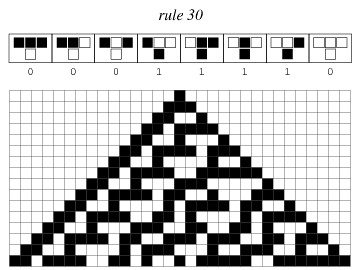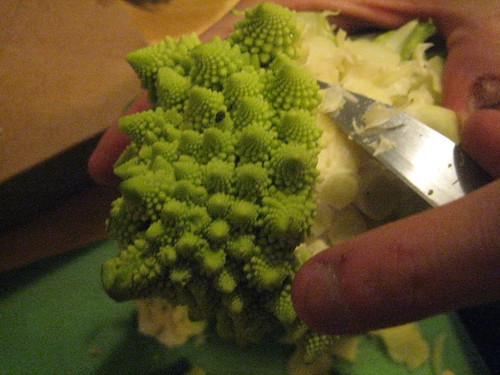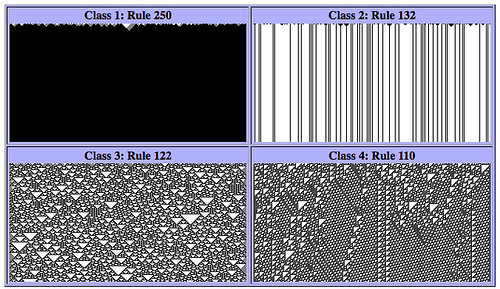Vegetables are important. They are also good for you. Here we have an especially important and delicious vegetable called the Romanesco Cauliflower.
But what exactaly is this vegetable? What is it doing in existence? And why does it exist? Some of these questions may be answered by looking into the mathematics behind natural things. One of the ways to model the patterns that cause things to come into being is Cellular Automata.
Cellular Automata
Cellular automata were studied in the early 1950s as a possible model for biological systems (Wolfram 2002, p. 48).
By using a grid and a series of rules, one can easily program something that appears very regular, fractal, or complex. The beauty is that these are very simple rules. A rule might be that if one square is black, the one below it should be white, but if the square above it on the left is black, then the square should be black.

British Mathematician and Physicist Steven Wolfram found that, “essentially regardless of details, the results of iterated computations fall into four general (although not entirely exclusive) classes.
“Class 1 computations produce uniform results from almost any input. Class 2 computations produce output which depends upon the input, but the results either stay the same forever or repeat with a short cycle time. Class 3 computations produce output which appears random (and often passes stringent tests of randomness), while Class 4 computations balance on the edge of order (Class 2) and chaos (Class 3), manifesting localised structures which move and interact with one another in complicated ways. Starting a one-dimensional cellular automaton with random input and various rules demonstrates the behaviour of the four classes of computation” (Walker, Fractal Food).
So Romanesco Cauliflower simply follows a rule of cellular automata (of course in a more interesting and actual way).

Fractal vegetables are also very delicious. Allow me to demonstrate with the following recipe:
Cauliflower and Brussels sprouts salad with mustard-caper butter
Total time: 30 minutes
Servings: 8
Note: From “Local Flavors” by Deborah Madison. Romanesco cauliflower is available at Bristol Farms and Whole Foods markets, select supermarkets and farmers markets. White cauliflower can be substituted.
Ingredients:
2 garlic cloves
Sea salt
Grated zest of 1 lemon
3 tablespoons chopped marjoram
Black pepper
1 pound Brussels sprouts
1 small head ( 1/2 pound) white cauliflower
1 small head ( 1/2 pound) Romanesco (green) cauliflower
1. To make the mustard-caper butter, pound the garlic with a half-teaspoon salt in a mortar until smooth. Stir the garlic into the butter with the mustard, capers, lemon zest and marjoram. Season to taste with pepper. (The butter can be made a day ahead and refrigerated. Bring to room temperature before serving.)
2. Trim the base off the Brussels sprouts, then slice them in half or, if large, into quarters. Cut the cauliflower into bite-sized pieces.
3. Bring a large pot of water to a boil and add salt. Add the Brussels sprouts and cook for 3 minutes. Then add the other vegetables and continue to cook until tender, about 5 minutes. Drain, shake off any excess water, then toss with the mustard-caper butter. Taste for salt, season with pepper and toss again.
Each serving: 108 calories; 2 grams protein; 6 grams carbohydrates; 2 grams fiber; 9 grams fat; 5 grams saturated fat; 23 mg. cholesterol; 281 mg. sodium.
[Source: LATimes Cooking Thing]





One Comment
Neat!